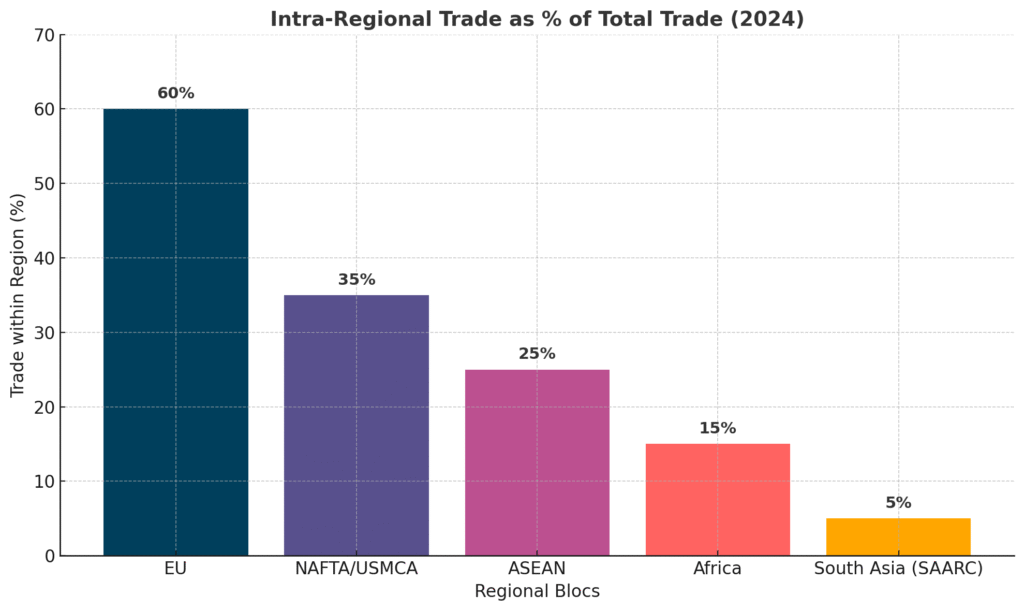Source: The Hindu (June 2025)
Link: Credit – The Hindu (for citation only; ensure hyperlink if used on a website
Context
Despite being home to nearly 25% of the global population, South Asia contributes less than 5% to global GDP and suffers from minimal intra-regional trade, making it one of the least integrated economic regions in the world.
This editorial critiques the underwhelming progress in regional economic integration and highlights the systemic barriers impeding cooperation among SAARC nations.
Key Arguments from the Editorial
- Political Mistrust and Bilateral Tensions
- Historic rivalry, especially between India and Pakistan, has hampered SAARC’s progress.
- Frequent border disputes, cross-border terrorism, and political nationalism have stalled multilateral cooperation.
- Low Intra-Regional Trade
- Intra-regional trade in South Asia is less than 5% of total trade, compared to:
- 25% in ASEAN,
- 60% in the EU,
- 35% in NAFTA (now USMCA).
- Non-tariff barriers (NTBs), poor logistics, and bureaucratic red tape worsen the problem.
- Intra-regional trade in South Asia is less than 5% of total trade, compared to:
- Stalled SAARC Mechanism
- SAARC summits have been irregular since 2014.
- Even mechanisms like SAFTA (South Asian Free Trade Area) remain poorly implemented.
- Lack of Physical and Digital Connectivity
- Cross-border infrastructure projects (e.g., railways, energy grids, trade corridors) face delays or cancellation.
- Visa regimes remain restrictive, inhibiting people-to-people and business-to-business contacts.
- Contrast with BIMSTEC
- The editorial notes how BIMSTEC, despite being newer, has shown greater potential for economic and strategic convergence—particularly with India’s Act East Policy.
Implications for South Asia
- Missed Economic Opportunity: World Bank estimates that regional trade could increase by $44 billion if trade barriers are lifted.
- Supply Chain Fragility: Weak integration affects resilience to global shocks like pandemics, oil price fluctuations, and food crises.
- China’s Influence: The vacuum in regional integration allows China to exert greater influence via Belt and Road Initiative (BRI) in Nepal, Sri Lanka, and Pakistan.
Way Forward (Editorial Suggestions)
- Revive SAARC with a practical agenda focused on trade, connectivity, and climate resilience.
- Promote bilateral or trilateral economic corridors where multilateral consensus is difficult.
- Deepen cooperation in energy trade, digital commerce, and green infrastructure.
- Encourage civil society, academic, and business networks to build trust and informal integration.
UPSC/Exam Relevance
Prelims:
- SAARC, SAFTA, BIMSTEC, BBIN initiatives
- Trade blocs and regional organizations
Mains – GS II & GS III:
- “Discuss the reasons behind poor regional economic integration in South Asia and suggest steps to strengthen it.”
- “Evaluate the effectiveness of SAARC in achieving its objectives in comparison to other regional blocs like ASEAN.”
Conclusion
This editorial underscores the paradox of South Asia—a region of shared culture and geography, yet riddled with political silos and economic fragmentation. Realizing the region’s potential will require both strategic diplomacy and grassroots economic connectivity beyond summits and declarations.
Credit: Original Editorial Published in The Hindu (June 2025)
Website: https://www.thehindu.comi
Infographics

Infographic comparing intra-regional trade as a percentage of total trade across major regional blocs. It clearly highlights how South Asia (SAARC) significantly lags behind others like the EU, NAFTA, and ASEAN, underscoring the urgent need for deeper economic integration in the region.
Main Question: Why is South Asia the Least Integrated Regional Bloc in Terms of Intra-Regional Trade?
➤ What does the data show?
- The infographic compares intra-regional trade (i.e., trade between member countries of a regional bloc) as a percentage of their total trade: RegionIntra-Regional Trade (%)European Union (EU)60%NAFTA / USMCA35%ASEAN25%African Union15%SAARC (South Asia)5% (lowest)
- This clearly shows that SAARC countries trade far less among themselves compared to other global regional blocs.
Question 2: What are the consequences of low intra-regional trade in South Asia?
➤ Impacts:
- Missed economic potential: World Bank estimates South Asia loses out on $44 billion annually due to under-trading.
- Weak supply chains: Makes the region vulnerable to global disruptions, like during COVID-19.
- China’s rising influence: Countries like Nepal, Pakistan, and Sri Lanka depend more on China for trade and investment than on neighbors.
- Lower regional resilience: During crises (climate, food, energy), cooperation is minimal or absent.
Question 3: What can South Asia learn from other regional blocs like ASEAN or the EU?
➤ Lessons from ASEAN/EU:
- Focus on economics over politics: ASEAN has managed to deepen trade despite political diversity.
- Invest in infrastructure corridors: ASEAN has cross-border railways, SEZs, and free movement of labor.
- Strong institutional mechanisms: EU has robust systems for trade, standards, and dispute resolution.
Question 4: How can India lead South Asia toward integration?
➤ India’s Role:
- Promote connectivity projects (BBIN, IMEEC, Kaladan Corridor)
- Use platforms like BIMSTEC and INSTC to bypass SAARC deadlock
- Liberalize trade with neighbors and reduce non-tariff barriers
- Champion digital trade, energy sharing, and disaster coordination

0 responses on "The Sorry State of South Asian Economic Integration: Editorial Analysis 24.june 2025"